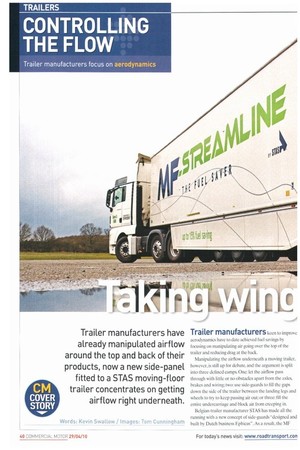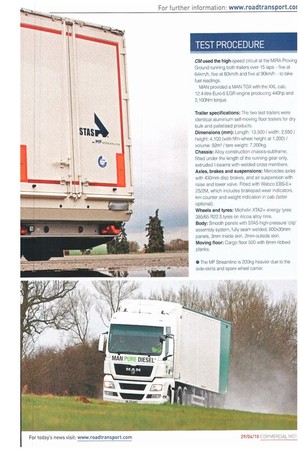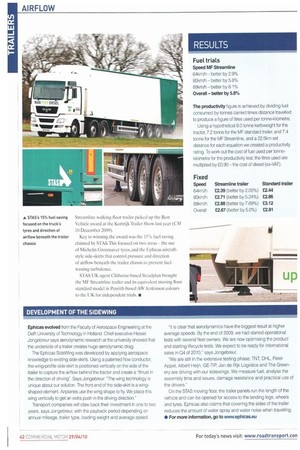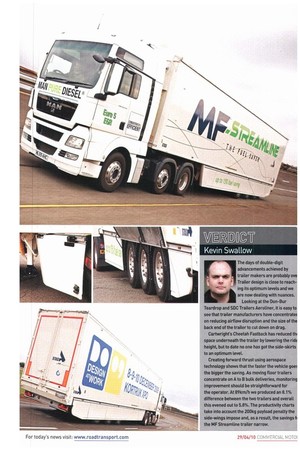CONTROLLING THE FLOW
Page 40

Page 41

Page 42

Page 43

If you've noticed an error in this article please click here to report it so we can fix it.
Trailer manufacturers focus on aerodynamics
Trailer manufacturers keen to improve aerodynamics have to date achieved fuel savings by focusing on manipulating air going over the top of the trailer and reducing drag at the back.
Manipulating the airflow underneath a moving trailer, however, is still up for debate, and the argument is split into three defined camps. One: let the airflow pass through with little or no obstacles apart from the axles, brakes and wiring; two: use side-guards to fill the gaps down the side of the trailer between the landing legs and wheels to try to keep passing air out; or three: fill the entire undercarriage and block air from creeping in.
Belgian-trailer manufacturer STAS has made all the running with a new concept of side-guards "designed and built by Dutch business Ephicas". As a result, the MF
TEST PROCEDURE
CM used the high-speed circuit at the MIRA Proving Ground running both trailers over 15 laps—five at 64km/h, five at 80km/h and five at 90km/h — to take fuel readings.
MAN provided a MAN TGX with the XXL cab.
12 4-Iltre Euro-5 EGR engine producing 440hp and 2,100Nrn torque.
Trailer specifications: The two test trailers were identical aluminium self-moving floor trailers for dry bulk and palletised products.
Dimensions (mm): Length: 13,500 / width: 2,550 / height: 4,100 (with fifth-wheel height at 1,200) / volume: 92m3/ tare weight: 7,200kg.
Chassis: Alloy construction chassis-subframe, fitted under the length of the running gear only, extruded l-beams with welded cross members. Axles, brakes and suspensions: Mercedes axles with 430mm disc brakes, and air suspension with raise and lower valve. Fitted with Wabco EBS-E+ 2S/2M, which includes brakepad wear indicators, km counter and weight indication in cab (latter optional).
Wheels and tyres: Michelin XTA2+ energy tyres 385/65 R22.5 tyres on Alcoa alloy rims.
Body: Smooth panels with STAS high-pressure 'clip' assembly system, fully seam welded, 600x3Omm panels 3mm inside skin. 2mm outside skin. Moving floor: Cargo floor 500 with 6mm ribbed planks.
AIRFLOW
Streamline walking-floor trailer picked up the Best Vehicle award at the Kortrijk Trailer Show last year (CM 10 December 2009).
Key to winning the award was the 15% fuel saving claimed by STAS. This focused on two areas the use of Michelin Greensavcr tyres, and the Ephicas aircraftstyle side-skirts that control pressure and direction of airflow beneath the trailer chassis to prevent fuelwasting turbulence.
STAS UK agent Clitheroe-based Steadplan brought the MF Streamline trailer and its equivalent moving floor standard model in Penrith-based AW Jcnkinson colours to the UK for independent trials. •
RESULTS
Fuel trials
Speed MF Streamline 64km/h -better by 2.9% 80km/h better by 5.8% 89km/h better by 8.1% Overall better by 5.8%
The productivity figure is achieved by dividing fuel consumed by tonnes carried times distance travelled to produce a figure of litres used per tonne-kilometre.
Using a hypothetical 8.0 tonne kerbweight for the tractor, 7.2 tonne for the MF standard trailer, and 7.4 tonne for the MF Streamline, and a 22.5km set distance for each equation we created a productivity rating. To work out the cost of fuel used per tonnekilometre for the productivity test, the litres used are multiplied by £0.90the cost of diesel (ex-VAT).
DEVELOPMENT OF THE SIDEWING
Ephicas evolved from the Faculty of Aerospace Engineering at the Delft University of Technology in Holland. Chief executive Hesse! Jongebreur says aerodynamic research at the university showed that the underside of a trailer creates huge aerodynamic drag.
The Ephicas SideWing was developed by applying aerospace knowledge to existing side-skirts. Using a patented flow conductor, the wing-profile side-skirt is positioned vertically on the side of the trailer to capture the airflow behind the tractor and create a "thrust in the direction of driving". Says Jongebreur: The wing technology is unique about our solution. The front end of the side-skirt is a wingshaped element. Airplanes use the wing shape to fly. We place this wing vertically to get an extra push in the driving direction."
Transport companies will claw back their investment in one to two years, says Jongebreur, with the payback period depending on annual mileage, trailer type, loading weight and average speed. "It is clear that aerodynamics have the biggest result at higher average speeds. By the end of 2009, we had started operational tests with several fleet owners. We are now optimising the product and starting lifecycle tests. We expect to be ready for international sales in 04 of 2010," says Jongebreur.
We are still in the extensive testing phase; TNT, DHL, Peter Appel, Albert Heijn, GE-TIP. Jan de Rijk Logistics and The Greenery are driving with our sidewings. We measure fuel, analyse the assembly time and issues, damage resistance and practical use of the drivers."
On the STAS moving floor, the trailer panels run the length of the vehicle and can be opened for access to the landing legs, wheels and tyres. Ephicas also claims that covering the sides of the trailer reduces the amount of water spray and water noise when travelling.
• For more information, go to www.ephicas.eu
Kevin Swallow
The days of double-digit advancements achieved by trailer makers are probably ove Trailer design is close to reaching its optimum levels and we are now dealing with nuances.
Looking at the Don-Bur Teardrop and SDC Trailers Aeroliner, it is easy to see that trailer manufacturers have concentratet on reducing airflow disruption and the size of the back end of the trailer to cut down on drag. Cartwright's Cheetah Fastback has reduced thi space underneath the trailer by lowering the rid( height, but to date no one has got the side-skirts to an optimum level.
Creating forward thrust using aerospace technology shows that the faster the vehicle goe2 the bigger the saving. As moving floor trailers concentrate on A to B bulk deliveries, monitoring improvement should be straightforward for the operator. At 89krniti we produced an 8.1% difference between the two trailers and overall this evened out to 5.8%. The productivity charts take into account the 200kg payload penalty the side-wings impose and, as a result, the savings fi the MF Streamline trailer narrow.




























































































































